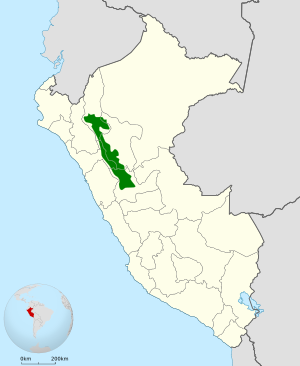Coppery metaltail facts for kids
The coppery metaltail (Metallura theresiae) is a type of hummingbird found only in Peru. It belongs to a group of hummingbirds called "coquettes."
Quick facts for kids Coppery metaltail |
|
|---|---|
| Conservation status | |
| Scientific classification | |
| Genus: |
Metallura
|
| Species: |
theresiae
|
 |
|
Contents
What is a Coppery Metaltail?
The coppery metaltail has two main types, called subspecies. They are named M. t. theresiae and M. t. parkeri.
How Does the Coppery Metaltail Look?
This hummingbird is about 10 to 10.5 cm (3.9 to 4.1 in) long. That's about the length of your hand! It weighs around 5 g (0.18 oz), which is super light. It has a straight, black beak that's not too long.
The male coppery metaltail has shiny, reddish-bronze feathers on its back. Its tail is a bronze-green with hints of purple. The sides of its head and neck are also reddish-bronze. It has a small, bright golden-green patch on its throat, called a gorget. The rest of its belly is a bronze-green, a bit less red than its back.
Female coppery metaltails look similar to males but are not as bright. Their throat patch is also smaller. Young birds do not have this shiny throat patch at all.
The M. t. parkeri subspecies looks a lot like the main type. However, its back is not as reddish, and the underside of its tail is a brighter golden-green.
Where Does the Coppery Metaltail Live?
The main type of coppery metaltail lives on the eastern side of the Peruvian Andes mountains. You can find it from east of the Marañón River down into the Huánuco area. The M. t. parkeri subspecies is only found in the Cordillera de Colán National Sanctuary in Peru's Amazonas region.
These birds like to live at the edges of special forests called elfin forests. They also live in places called páramo. These are moist areas with lots of shrubs and small trees. They live high up in the mountains, between 2,800 and 3,550 m (9,200 and 12,000 ft) above sea level.
How Does the Coppery Metaltail Live?
Movement
Scientists believe the coppery metaltail stays in the same area all year round. It does not migrate to other places.
Feeding
The coppery metaltail mostly drinks nectar from flowers. However, we don't know all the details about what else it eats. Male birds often protect their favorite feeding spots from other birds. Besides nectar, it also catches small arthropods, like insects. It does this by flying out from a branch to snatch them in the air.
Breeding
We don't know much about how the coppery metaltail builds its nest or raises its young. Scientists think their breeding season might be in August and September.
Vocalization
The coppery metaltail makes calls that sound like a series of weak "zeee" sounds. These often switch with "ttrrrt" notes. Some people describe its calls as a quick, wiry chatter. It's similar to the Tyrian Metaltail's call, but perhaps lower and buzzier.
Is the Coppery Metaltail Safe?
The IUCN (International Union for Conservation of Nature) says the coppery metaltail is a species of "Least Concern." This means it's not currently in danger of disappearing. However, we don't know exactly how many of these birds there are. Their numbers are thought to be going down.
Even though not many people live in their high mountain homes, there is a threat. People sometimes burn the páramo areas to create land for animals to graze. This burning can harm the coppery metaltail's habitat.
See also
 In Spanish: Metallura theresiae para niños
In Spanish: Metallura theresiae para niños


